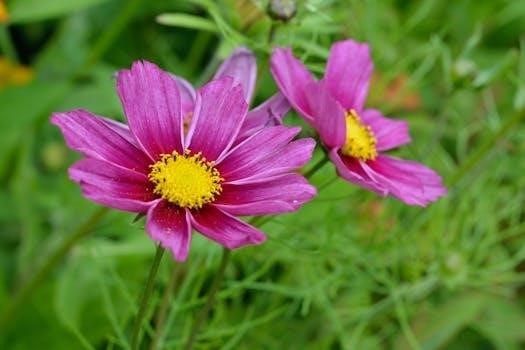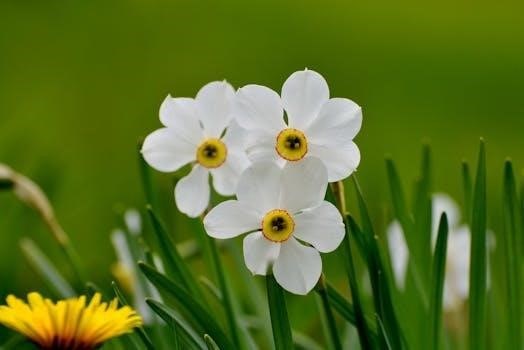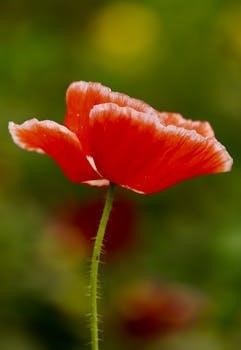
newcomb’s wildflower guide
Overview of Newcomb’s Wildflower Guide
Newcomb’s Wildflower Guide is a classic, revolutionary resource, enabling quick and accurate wildflower identification․ It utilizes an identification system based on easily visible natural structural features, appealing to both amateurs and experts․
Key Identification System
The key identification system relies on natural structural features, easily observed even by untrained eyes․ It uses a series of questions about plant structures, directing users to the correct page․
Structural Features Based Identification
The core of Newcomb’s system lies in identifying wildflowers based on their inherent structural features, a method designed for accessibility and accuracy․ This approach focuses on characteristics readily visible to the naked eye, eliminating the need for specialized botanical knowledge․ By observing elements such as leaf arrangement, flower type, and stem structure, users can navigate the guide’s organized system․
This emphasis on structural features allows for a more intuitive identification process compared to methods relying on color or complex terminology․ The guide effectively translates botanical intricacies into easily understandable observations․ The system’s brilliance lies in its ability to empower anyone, regardless of their botanical background, to confidently identify wildflowers in the field․ This method ensures that the identification process remains straightforward and efficient, promoting a deeper appreciation for the natural world․
Five Question Key Method
Newcomb’s Wildflower Guide employs a unique and efficient identification system centered around a “Five Question Key Method․” Upon encountering an unknown wildflower, the user is prompted to answer a series of five specific questions related to the plant’s observable characteristics․ These questions are designed to progressively narrow down the possibilities, leading the user towards the correct identification․
The questions typically revolve around easily discernible features such as flower structure, leaf arrangement, and overall plant morphology․ By answering these questions sequentially, the user is directed to a specific section within the guide, significantly reducing the search area․ This method streamlines the identification process, making it faster and more accurate than traditional methods․ The five question approach simplifies complex botanical information into manageable steps․

Illustrations and Visual Aids
Newcomb’s Wildflower Guide utilizes clear and beautiful illustrations to aid identification․ These visuals highlight important details, surpassing photographs by focusing on key structural features for accurate plant recognition․
Clear and Precise Illustrations
The illustrations within Newcomb’s Wildflower Guide stand out for their clarity and precision, a crucial element for effective plant identification․ Unlike color photographs that can sometimes overwhelm with extraneous details, these illustrations are carefully crafted to highlight the essential features of each wildflower, flowering shrub, and vine․ By focusing on the key structural characteristics, such as leaf shape, petal arrangement, and stem structure, the illustrations provide a visual aid that is both informative and easy to understand․ This approach allows users, regardless of their botanical expertise, to quickly grasp the defining traits of a plant and compare it to the illustrations in the guide for accurate identification․ The emphasis on precision ensures that even subtle differences between species are readily apparent, making the guide a reliable tool for both amateur and professional botanists․ The detailed nature of the illustrations contributes significantly to the overall user-friendliness and effectiveness of Newcomb’s Wildflower Guide․
Highlighting Important Details
The effectiveness of Newcomb’s Wildflower Guide lies not only in its clear illustrations but also in its strategic highlighting of important details․ The illustrations don’t just present a general overview of each plant; they meticulously emphasize the key characteristics that distinguish it from others․ This focus on detail is crucial for accurate identification, especially when dealing with similar species․ By drawing attention to specific features like vein patterns, petal shapes, and the arrangement of floral parts, the guide ensures that users can quickly and confidently identify even the most challenging wildflowers․ This approach contrasts with guides that rely solely on color photographs, which can sometimes obscure important structural details․ Newcomb’s Wildflower Guide prioritizes clarity and precision, making it easier for users to discern subtle differences and arrive at a correct identification․ The result is a user-friendly and reliable tool for anyone interested in learning more about the wildflowers around them․

User Friendliness and Accessibility
Newcomb’s Wildflower Guide is designed for everyone, from novices to botanists․ Its user-friendly key simplifies plant identification, making it accessible to all ages and experience levels, fostering a love for nature․
Suitable for Amateurs and Experts
Newcomb’s Wildflower Guide bridges the gap between amateur enthusiasts and seasoned botanists, offering a unique identification system․ Its clear, concise approach makes it easy for beginners to learn the basics of wildflower identification, while its detailed information and comprehensive coverage cater to the needs of experienced naturalists․ The guide’s structural feature based system eliminates reliance on specialized knowledge, allowing anyone to confidently identify plants in the field․ Whether you are just starting to explore the world of wildflowers or are a professional seeking a reliable reference, Newcomb’s provides the tools and information you need․ Its ingenious key and beautiful illustrations make learning enjoyable and effective, encouraging both casual observers and dedicated researchers to delve deeper into the fascinating world of wildflowers․ This guide truly empowers individuals of all skill levels to connect with nature․
Easy to Learn Key for All Ages
Newcomb’s Wildflower Guide is celebrated for its user-friendly key, making wildflower identification accessible to individuals of all ages․ The key’s simplicity stems from its reliance on easily observable structural features, eliminating the need for specialized botanical knowledge․ Its five-question method guides users step-by-step through the identification process, making it intuitive and engaging for both children and adults․ The guide’s clear illustrations further enhance the learning experience, providing visual confirmation and reinforcing the key’s descriptions․ With Newcomb’s, families can explore nature together, fostering a love for the natural world and developing valuable identification skills․ The guide’s age-appropriate approach ensures that everyone, from young children to seniors, can confidently identify wildflowers and deepen their appreciation for the beauty and diversity of plant life, turning every nature walk into an educational adventure․

Coverage Area
Newcomb’s Wildflower Guide focuses on wildflowers, flowering shrubs, and vines in Northeastern and North-central North America․ This geographical specificity ensures accuracy and relevance for users within this region, making identification straightforward․
Northeastern and North-Central North America
The guide’s primary focus is on the flora of Northeastern and North-Central North America, ensuring its relevance and accuracy for users within this specific geographical area․ This targeted approach allows for a more comprehensive and detailed exploration of the wildflowers, flowering shrubs, and vines commonly found in these regions․ Newcomb’s Wildflower Guide serves as an invaluable tool for identifying plant species across states like Maine, New York, Michigan, and Wisconsin․ The guide offers a curated selection of plants prevalent in these areas, improving identification accuracy․ Its detailed descriptions and illustrations cater specifically to the local flora․ By concentrating on this defined region, Newcomb’s provides greater precision, helping both amateur and expert naturalists identify plants with confidence․ The regional focus ensures the guide remains practical and applicable in the field․

Longevity and Continued Use
Despite being nearly half a century old, Newcomb’s Wildflower Guide remains in print and actively used․ Its enduring popularity highlights its effectiveness and relevance for wildflower identification, even today․
Still in Print and in Use After Decades
Despite its initial publication many years ago, Newcomb’s Wildflower Guide has demonstrated remarkable longevity, remaining continuously in print and actively utilized by both amateur and professional botanists․ This enduring presence speaks volumes about the guide’s effectiveness, accuracy, and user-friendliness in identifying wildflowers․ The continued demand for Newcomb’s Wildflower Guide highlights its timeless appeal and its ability to remain relevant in a field where new resources and technologies are constantly emerging․ Its simple key system and clear illustrations have made it a trusted companion for generations of nature enthusiasts, solidifying its place as a classic in the world of wildflower identification․ The guide’s ongoing availability ensures that future generations can benefit from its unique approach and wealth of information, ensuring its legacy for years to come․